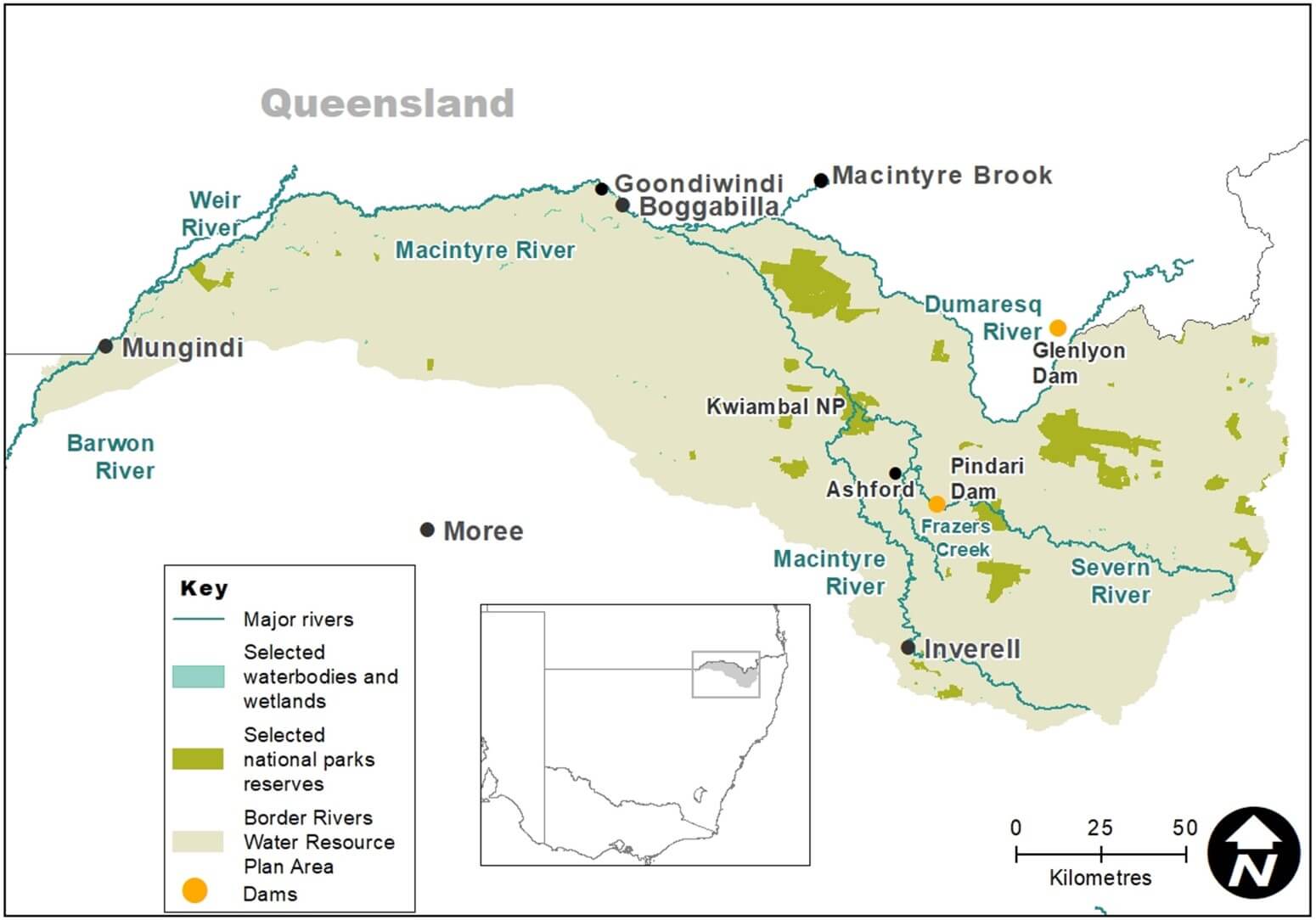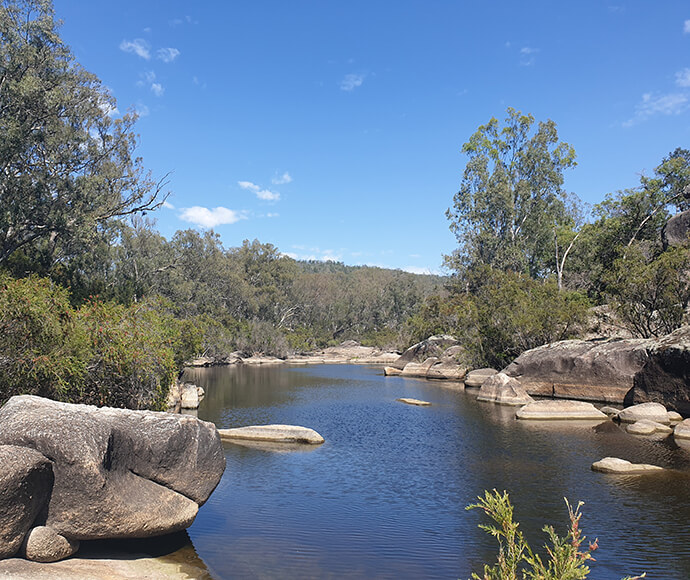The Border Rivers catchment straddles the Queensland–New South Wales border, with about 50% of its area in each state, covering 24,000 square kilometres in total. In New South Wales the Border Rivers catchment includes numerous anabranches, waterholes and wetlands on a semi-arid floodplain in a relatively low rainfall zone.
The region had suffered severe drought since mid-2017 with rain in early 2020 easing these conditions, though the catchment remained dry until early 2021. Conditions continued to improve with moderate flooding occurring in March–April 2021 and wet conditions continuing into winter. Delivery of minimum daily flow requirements continued from Pindari Dam throughout the 2020–21 water year, but these only maintained flow to Ashford.
In 2019–20 translucent flows (environmental water under water sharing plan rules) were not delivered due to valve maintenance and the undelivered volume was set aside in a payback account. This made approximately 10 gigalitres of translucent flow payback water available for use in 2020–21.
Key outcomes
The release of a stimulus flow from Pindari Dam was triggered in October 2020 and delivered the first small fresh between Pindari and Frazers Creek since February 2019. This release of 4.3 gigalitres provided a stable flow to help Murray cod and freshwater catfish recruitment.
The 10 gigalitres of translucent flow payback water was used to provide base flows, contribute to refuge pool replenishment and provide a pre-winter small fresh:
- Just over 2.3 gigalitres provided a stable base flow of 50 megalitres per day from November 2020 to April 2021, in addition to translucent releases resulting from inflows.
- In late December 2020 and early January 2021, 2.8 gigalitres was piggybacked on a WaterNSW block release to Mungindi to replenish refuges in the Barwon River. The Commonwealth Environmental Water Holder contributed an additional 900 megalitres from Pindari Dam to this event.
- The remaining approximately 5 gigalitres provided a pre-winter small fresh to increase system productivity and improve pre-winter condition of native fish.

Border Rivers catchment area map
Watering aims
Water managers adopted a flexible and responsive approach in 2020–21, with an expected dry resource availability scenario as identified in the NSW Border Rivers catchment: Annual environmental watering priorities 2020–21. This approach acknowledged natural cues and met the water needs of the environment across a range of systems and climatic conditions.
The NSW Border Rivers catchment began the 2020–21 year with access to 8 gigalitres of stimulus account and more than 10 gigalitres of translucent flow payback water. Low water allocations provided little access to licensed environmental water following the prolonged dry spell.
Small freshes and base flows were used to maintain river function in the Severn and Macintyre rivers. NSW and Commonwealth Environmental Water Holder holdings were limited, therefore water was not delivered to wetlands.
Outcomes
The 2 aims of the NSW Border Rivers: Annual environmental watering priorities 2020–21 under a dry scenario were met by releases of water for the environment and natural flows in the 2020–21 water year:
- maintain river function
- maintain key functions of high priority wetlands.
River function was maintained through the Severn and Macintyre rivers through a combination of environmental deliveries and natural flows. River function was maintained in the Dumaresq River through natural flows alone with no water for the environment released from Glenlyon Dam.
The lower Macintyre River experienced cease-to-flow conditions for a short period in late spring–early summer before reconnecting in December–January. A block release including translucent flow payback water and water for the environment held by the Commonwealth Environmental Water Holder, as well as natural flows from the Macintyre Brook, returned flows to the lower Macintyre River. Connection in this part of the system was maintained to June 2021.
Key functions of high priority wetlands were maintained by high flows in March and April with moderate flooding experienced at Goondiwindi.
Case study: Severn River stimulus flow supports native fish
In October 2020, 4354 megalitres of water was delivered from Pindari Dam in a single event under the stimulus flow rule in the Border Rivers Regulated Water Source Water Sharing Plan 2009.
Due to the drought, the stimulus flow had not been available since it was last used in 2017. Few natural events had occurred in the system until March 2020. Analysis of late autumn and early spring flows showed a deficiency in small fresh events. The stimulus flow was the first small fresh between Pindari and Frazers Creek since February 2019 and provided a much-needed boost for the system as it recovered from years of drought.
A release strategy was developed in consultation with Department of Planning, Industry and Environment – Water, Department of Primary Industries (DPI) – Fisheries, and the Commonwealth Environmental Water Office. A sustained small rise in river levels was timed to coincide with spawning of Murray cod and freshwater catfish.
Murray cod and freshwater catfish establish nests in which they lay eggs. The parents attend the nest and keep the site clear of smothering sediment and predators. Stable flows help maintain water levels to inundate nests and avoid parental abandonment before eggs hatch. A gradual recession of water levels allowed dispersal of larval fish.
Freshwater catfish were observed on their nests and surveys by DPI – Fisheries recorded larval freshwater catfish and Murray cod. The flow was also timed to minimise impacts of cold-water pollution. Water quality monitoring showed that temperatures remained in a favourable range for spawning and recruitment of Murray cod and freshwater catfish.
The stimulus flow account retains 7646 megalitres for use in the 2020–21 water year.

Severn River in Kwiambal National Park